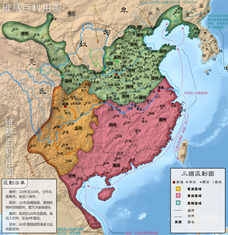
Chinese History 101 #03: Era of Fragmentation
Last updated: Saturday September 18th, 2021
Report this blog
From where we left off
In the previous blog, I talked about how Cao Cao put Emperor Xian under his control and tried to unify the empire, but suffered embarrassing defeat at the Battle of Red Cliffs against the alliance of Sun Quan and Liu Bei (note that Sun Quan isn't pronounced "son kwan" as you may think, listen here on how it should be pronounced).
Although relatively short, the Three Kingdoms period has been greatly romanticised in China and abroad, popularised in operas, folk stories, novels and in more recent times, films, television, video and card games. In fact, most Chinese people nowadays would mix up legends with historical facts about this period. Therefore I will expand a bit more on the stories during this period (starting from the end of the blue and start of the grey bit below).
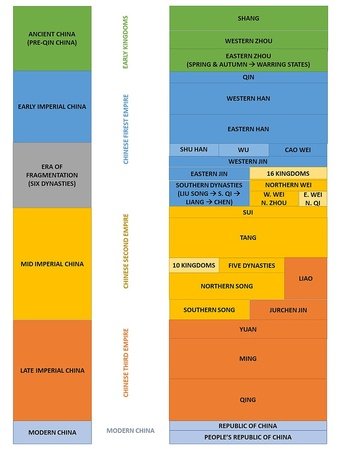
The period leading up to the Three Kingdoms (184 - 220 AD)
Liu Bei was a distant descendant of the Han imperial family but had a humble upbringing. He was a charismatic leader and had a loyal following including his famous generals Guan Yu and Zhang Fei, who the three shared a brotherly relationship.
In 194, the 33-year-old Liu Bei inherited the Xu Province upon the wish of the dying governor Tao Qian. Two years later, another warlord Lü Bu, who sought refuge in Liu Bei after beaten by Cao Cao, seized the province and Liu's wife while Liu Bei was away fighting. After many conflicts, Liu Bei had no choice but to serve under Cao Cao, who treated him well and regarded him highly. Cao and Liu defeated and killed Lü Bu, and Liu Bei got his wife back but not the province.
Cao Cao once said to Liu Bei "currently among the heroes of the empire, there is only you and I". Liu Bei was very shocked and sensed the danger that Cao Cao was testing his loyalty, so he defected in 200. But he was quickly defeated by Cao Cao and had to flee south to the Jing Province.
Meanwhile, 18-year-old Sun Quan inherited the lands southeast of the Yangtze River from his brother who was assassinated in year 200. With helps from his able advisers, Sun Quan continued to build up his strength along with Yangtze River. But by winter 207, he faced an imminent invasion from Cao Cao, who claimed to have a force of 800,000 strong (historian estimated to be 220,000 instead).
In 207, Liu Bei sought advice from a scholar named Zhuge Liang, who told him to seek alliance with Sun Quan in order to resist Cao Cao, and to secure a viable base in the Jing and Yi provinces in the Southwest.

The alliance proved to be highly successful. The combined force of 50,000 successfully defeated Cao Cao at Red Cliffs (southwest of Wuhan) in early 208. This is the most famous battle in the thousands years of Chinese history. The storyline (some real some fictional) and the winning tactic of burning Cao Cao's fleet are well known to all literate Chinese people.
After the war, Liu Bei continued to follow Zhuge's plan to expand towards Jing and Yi provinces. Sun Quan further strengthened the alliance with Liu Bei by marrying his younger sister to Liu, and letting Liu take over part of Jing Province for his expansion into Yi Province.
In 214, Liu Bei successfully took over Chengdu with the help of Zhuge Liang as his chancellor. In 215, Cao Cao took over Hanzhong and threatened Liu Bei. Liu Bei launched the Hanzhong Campaign in 217 and successfully drove Cao Cao out of the area in 219.
An interesting story during the Hanzhong war was the "chicken ribs" incident. One night, a messenger asked Cao Cao for the night verbal code. Cao Cao was having chicken soup and aimlessly answered "chicken ribs". His adviser Yang Xiu heard that and told the troops to prepare for packing, as he saw the metaphor that chicken ribs had no meat in them but it would be a pity to throw them out. Although he correctly guessed Cao Cao's hidden thoughts, Cao Cao executed him for his recklessness in sharing it with others and affecting the troops morale. In Chinese idioms, "Yang Xiu" is used to describe smart-arses, and "chicken ribs" to describe useless things that people hang on to.
Once Sun Quan knew that Liu Bei captured Hanzhong, he requested Liu Bei to hand back the Jing Province. When Liu Bei refused, Sun Quan formed an alliance with Cao Cao to fight against Guan Yu at Jing Province. Guan Yu was captured and Sun Quan executed him and sent his head to Cao Cao. The alliance between Sun Quan and Liu Bei thus formally collapsed.
Note that Guan Yu became a deity in Chinese religions including Taoism and is widely worshipped by criminal gangs as well as the police for his fraternity, loyalty and heroism.
Another common Chinese idiom is "Liu Bei borrowed Jing Province", meaning that a person does not return things he borrows. But whether Sun Quan did lend Jing Province to Liu Bei was disputed by historians, as Jing Province was not "owned" by Sun Quan in the first place.

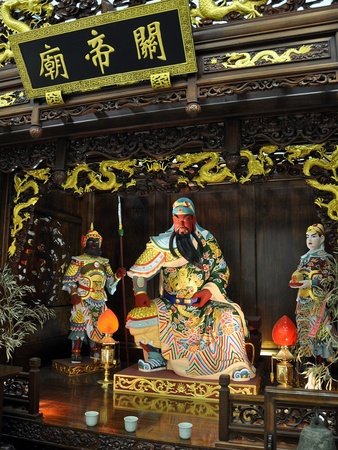
Three Kingdoms (220 - 280 AD)
In 220, Cao Cao died and succeeded by his son Cao Pi, who proclaimed himself the Emperor of Wei. Liu Bei responded by proclaiming himself the Emperor of Han. Unlike Liu Bei, Sun Quan took a wait-and-see approach. Fearing attacks from both sides, Sun Quan became a vassal of Wei and Cao Pi granted him the title "King of Wu".
To avenge the death of Guan Yu, Liu Bei declared war on Sun Quan in 221 but suffered heavy losses. Meanwhile, Cao Pi demanded Sun Quan to send his son to the capital Luoyang as a hostage, which Sun Quan ignored. Sun Quan made peace with Liu Bei while successfully defended against Cao Pi's attacks and declared independence in 222. Sun Quan finally declared himself Emperor of Wu in Jianye (today Nanjing) in 229 and the Three Kingdoms emerged.
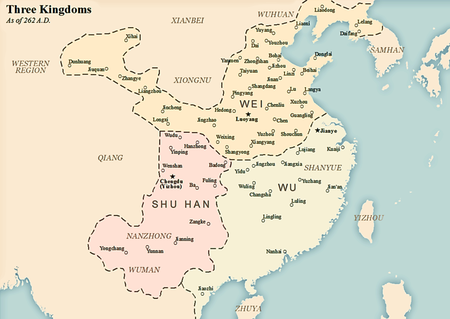
After suffering crushing defeat from Sun Quan, Liu Bei retreated and died a year later in 223 from illness. He appointed Zhuge Liang as regent, who launched five unsuccessful Northern Expeditions against Wei between 228 until his death in 234. After that, Shu Han slowly declined with further unsuccessful wars against Wei. In 263, Wei invaded Shu Han and Liu Bei's son Liu Shan surrendered and was settled in Luoyang afterwards as a duke with no power. The Chinese idiom "happy not to think about Shu", which means feeling contented, originated from Liu Shan when he was asked whether he missed Shu Han and he replied "No, I'm happy here".
As for Wei, while it kept fighting against attacks from Shu Han, Wu and the Korean kingdom Goguryeo, its state authority gradually fell to its regent Sima Yi and his family after a coup. Soon after conquering Shu Han, his grandson Sima Yan forced the abdication and replacing Wei with the Jin dynasty in 266. He then started preparing for the reunification. The invasion of Wu finally came at the end of 279 with five simultaneous offensives along the Yangtze River. After five months, Wu surrendered and the Three Kingdoms ended in 280.
Western Jin Dynasty (266 - 316 AD)
Similar to the Zhou and Han dynasties, the first part of the Jin dynasty is historically called the Western Jin. After conquering Wu, the unity was short-lived. When the throne was passed onto Emperor Hui who was mentally retarded, succession crisis turned into civil wars among the princes and greatly weakened the empire.
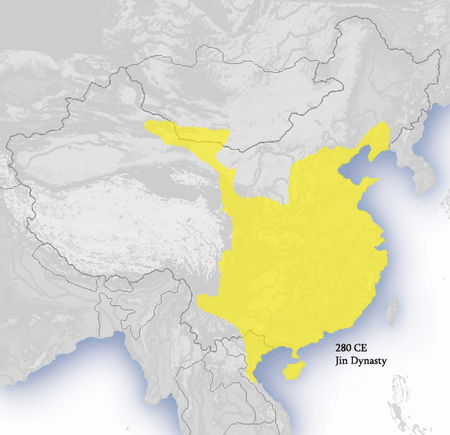
Since the Eastern Han, nomads from the North and the West including the Xiongnu started migrating to northern China, mixing with and assimilating into the Chinese culture. Many were mistreated by the Han Chinese and worked as slaves. When civil wars broke out in the Western Jin, the Xiongnu established a dynasty called Han in Bing Province (today Shanxi) in 304. They invaded Luoyang in 311, capturing the emperor and empress, killing the crown prince, a host of ministers, and over 30,000 civilians. They looted and burnt down the palaces and dug up Jin mausoleums. One of the princes escaped to Chang'an and ascended to the throne, only to be captured and killed by the Xiongnu in 316 and thus the Western Jin ended.
Eastern Jin Dynasty and the Sixteen Kingdoms (317 - 420 AD)
Sima Rui, who was a great grandson of Sima Yi and based in Jiankang (today Nanjing) declared himself king in 317 when the news of the fall of Chang'an arrived, marking the start of the Eastern Jin. Northern China was occupied by 16 short-lived kingdoms founded by the Five Barbarians at various times. The chaos in the North led to mass migration of Han Chinese population from the Yellow River to the Yangtze River and the South.
Note that many of these 16 kingdoms shared the same names, and historians added the "former", "later", "north", "south" and "west" prefixes to distinguish them.
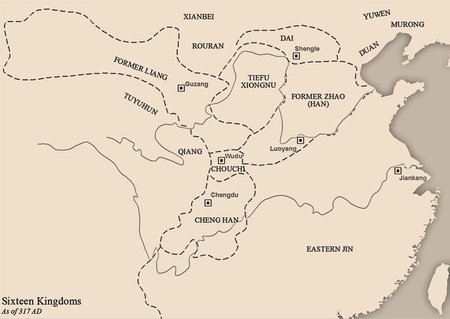
A watershed in the Sixteen Kingdoms period was when the Former Qin of the Di ethnic group unified the North in 376 and was preparing to invade the Eastern Jin, threatening the survival of the Han Chinese empire. In 383, an army of 870,000 from the Former Qin fought the 80,000 elite troops from the Eastern Jin at the Battle of Fei River (near today Huainan), which is considered one of the most significant battles in the Chinese history.
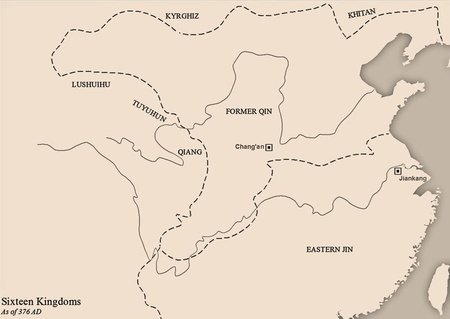
Although the Eastern Jin army was vastly outnumbered, they were well motivated to protect their homeland, while the Former Qin army were largely conscripts from many different ethnic groups and had little loyalty, little training and low morale. The Jin elite troops first engaged the advance Qin force and scored a devastating victory. The Jin general then messaged the Former Qin side, suggesting them to retreat slightly to allow the Jin troops to cross the Fei River so that the two armies could engage. The Former Qin side agreed, thinking that they could attack when the Jin side was crossing the river. The Jin's tactics and the previous ambush paid off, as many soldiers wondered why a sudden retreat order was given. The Qin army panicked when the Jin side started yelling "the Qin army has been defeated", causing a stampede which killed their general. The Jin side then chased them off and by the time the Qin side retreated back to the North, 70-80% of their troops were dead.
After the Battle of Fei River, the Former Qin quickly fell apart as various regimes in the North broke loose.
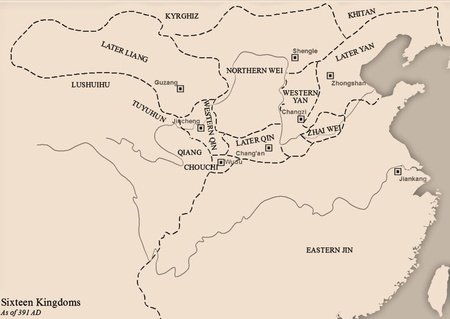
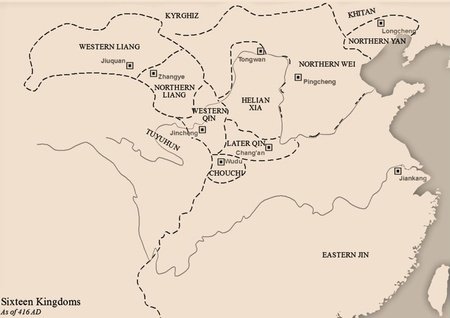
Although the Eastern Jin regained territories after the war, its administration slowly declined and was eventually usurped by general Liu Yu in 420.
Meanwhile, the State of Dai from the Xianbei clan of Tuoba, which later renamed Wei and commonly known as the Northern Wei, reunified the North in 439, marking the end of the Sixteen Kingdoms period.
Northern and Southern Dynasties (420 - 589 AD)
The Northern and Southern dynasties period consisted of four Southern dynasties (Song, Qi, Liang and Chen) ruled by Han Chinese, and five Northern dynasties (Northern Wei, Western Wei, Eastern Wei, Northern Zhou and Northern Qi) ruled by Sinicised Xianbei.
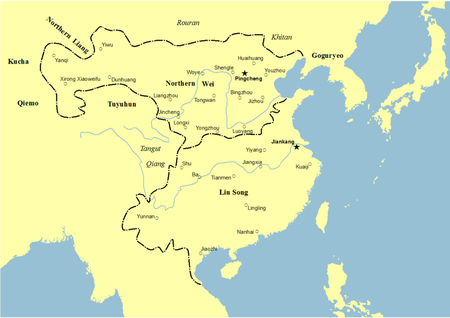
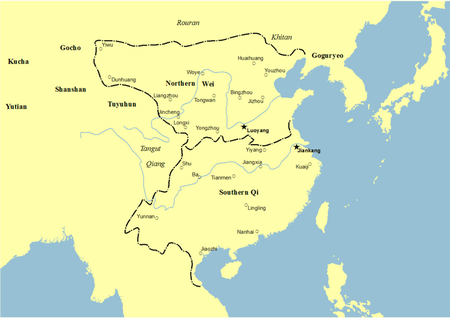

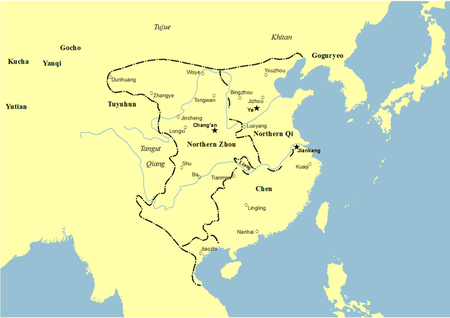
In the North, Emperor Xiaowen of Northern Wei, whose mother was Han Chinese, implemented a policy of Sinicisation by moving the capital to Luoyang in 494, changing Xianbei surnames to Chinese ones (the royal house of Tuoba was changed to Yuan), banning officials from speaking the Xianbei language, switched to Chinese clothing, encouraging Xianbei men to marry Han women, and promoting Confucius education. However, this caused a rift between the Sinicised bureaucrats in Luoyang and the traditional Xianbei military in the north, leading to a revolt in 523 that greatly weakened the Northern Wei.
The Northern Wei split into Eastern and Western Wei in 534 when rival rebel generals set up their puppet states. These were replaced by Northern Qi and Northern Zhou when the generals' sons claimed the thrones for themselves.
In the South, the Eastern Jin was succeeded by four short-lived dynasties. The rulers were generals who seized and then held power for several decades, but were unable to securely pass power onto their heirs successfully. During the chaos in the Northern Wei, Emperor Wu of Liang had some success in recovering land against Wei but did not go further north due to heavy casualties. In 548, a rebel Eastern Wei commander Hou Jing who sought asylum in Liang was sent by Emperor Wu on Northern Expeditions against the Eastern Wei. When Emperor Wu's nephew was captured by the Eastern Wei, Emperor Wu wanted to swap Hou Jing with him. Hou Jing revolted and besieged the capital Jiankang. Emperor Wu died of hunger, widespread starvation and cannibalism occurred, and the capital population dropped from 100,000 to less than 4000 when the siege ended.
The Southern dynasties were in turmoil after the Hou Jing Rebellion and lost vast territories to the North. In 577, the Northern Zhou conquered the Northern Qi and reunified the North, but within 3 years it was overthrown by Yang Jian who established the Sui dynasty. In 588, Sui invaded Chen and reunified the whole country in the following year, ending 400 years of separation and chaos in China.
The end of the third blog
This marks the end of my third blog on Chinese history. The first three blogs cover the entire Year 7 History syllabus in Chinese schools.
I put a lot of details into this blog, especially on the Three Kingdoms and the Battle of Fei River because these are significant and popular in Chinese culture. So this blog is a bit more than an 101 introductory course as I originally intended. I hope you enjoy reading and learn something from it.

The classical Mulan Lyrics is studied by all Chinese students at about Year 8 and most people would be able to at least recite the first few lines.
Great job as always!